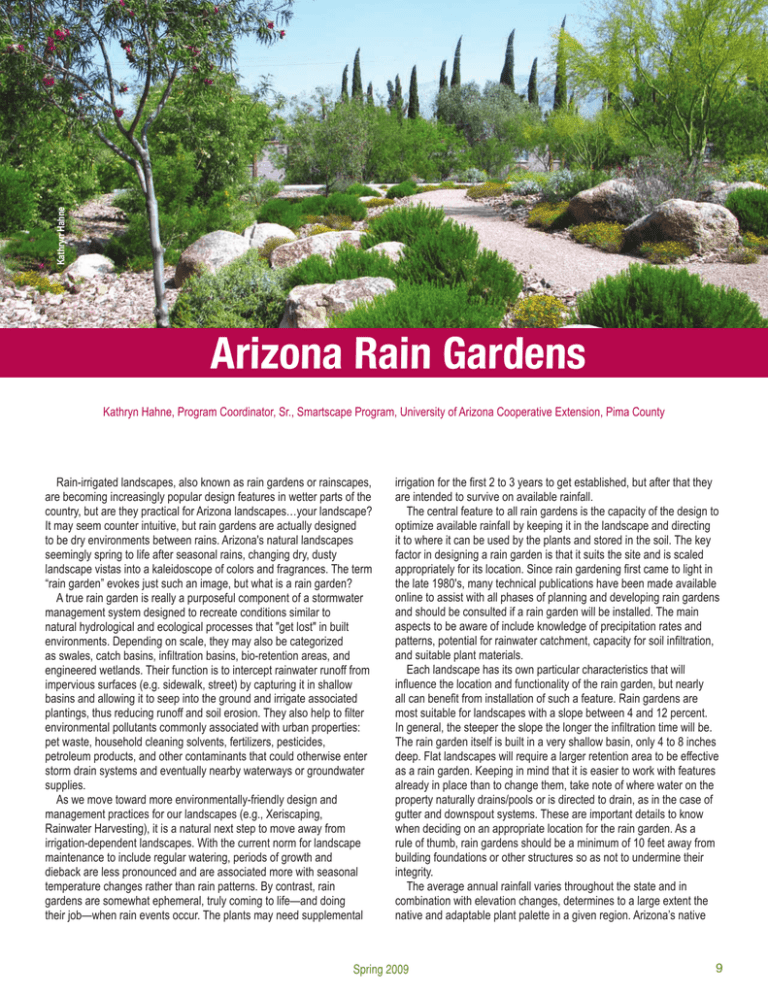Arizona Rain Gardens
advertisement

Kathryn Hahne Arizona Rain Gardens Kathryn Hahne, Program Coordinator, Sr., Smartscape Program, University of Arizona Cooperative Extension, Pima County Rain-irrigated landscapes, also known as rain gardens or rainscapes, are becoming increasingly popular design features in wetter parts of the country, but are they practical for Arizona landscapes…your landscape? It may seem counter intuitive, but rain gardens are actually designed to be dry environments between rains. Arizona's natural landscapes seemingly spring to life after seasonal rains, changing dry, dusty landscape vistas into a kaleidoscope of colors and fragrances. The term “rain garden” evokes just such an image, but what is a rain garden? A true rain garden is really a purposeful component of a stormwater management system designed to recreate conditions similar to natural hydrological and ecological processes that "get lost" in built environments. Depending on scale, they may also be categorized as swales, catch basins, infiltration basins, bio-retention areas, and engineered wetlands. Their function is to intercept rainwater runoff from impervious surfaces (e.g. sidewalk, street) by capturing it in shallow basins and allowing it to seep into the ground and irrigate associated plantings, thus reducing runoff and soil erosion. They also help to filter environmental pollutants commonly associated with urban properties: pet waste, household cleaning solvents, fertilizers, pesticides, petroleum products, and other contaminants that could otherwise enter storm drain systems and eventually nearby waterways or groundwater supplies. As we move toward more environmentally-friendly design and management practices for our landscapes (e.g., Xeriscaping, Rainwater Harvesting), it is a natural next step to move away from irrigation-dependent landscapes. With the current norm for landscape maintenance to include regular watering, periods of growth and dieback are less pronounced and are associated more with seasonal temperature changes rather than rain patterns. By contrast, rain gardens are somewhat ephemeral, truly coming to life—and doing their job—when rain events occur. The plants may need supplemental irrigation for the first 2 to 3 years to get established, but after that they are intended to survive on available rainfall. The central feature to all rain gardens is the capacity of the design to optimize available rainfall by keeping it in the landscape and directing it to where it can be used by the plants and stored in the soil. The key factor in designing a rain garden is that it suits the site and is scaled appropriately for its location. Since rain gardening first came to light in the late 1980's, many technical publications have been made available online to assist with all phases of planning and developing rain gardens and should be consulted if a rain garden will be installed. The main aspects to be aware of include knowledge of precipitation rates and patterns, potential for rainwater catchment, capacity for soil infiltration, and suitable plant materials. Each landscape has its own particular characteristics that will influence the location and functionality of the rain garden, but nearly all can benefit from installation of such a feature. Rain gardens are most suitable for landscapes with a slope between 4 and 12 percent. In general, the steeper the slope the longer the infiltration time will be. The rain garden itself is built in a very shallow basin, only 4 to 8 inches deep. Flat landscapes will require a larger retention area to be effective as a rain garden. Keeping in mind that it is easier to work with features already in place than to change them, take note of where water on the property naturally drains/pools or is directed to drain, as in the case of gutter and downspout systems. These are important details to know when deciding on an appropriate location for the rain garden. As a rule of thumb, rain gardens should be a minimum of 10 feet away from building foundations or other structures so as not to undermine their integrity. The average annual rainfall varies throughout the state and in combination with elevation changes, determines to a large extent the native and adaptable plant palette in a given region. Arizona’s native Spring 2009 9 on the periphery or upper portions of the basin while wet- and moistureloving plants are better suited to the lower portions. Mesic plants are good mid-level choices. For year-round interest, choose annual and perennial native plants. In general, woody species (i.e., shrubs and trees) will comprise the foundation plants, giving structure to the design. Perennial groundcovers and native grasses are good choices for continuity of the design. Accent plants provide focal points and annuals and biennials are used primarily for color and seasonal interest and can be changed accordingly. The question remains, which plants to use? Advocates of rain gardening insist on native plants, but many plants are adaptable to this type of landscaping and should be considered if they appeal to the homeowner. The easiest way to make good choices is to observe what grows well in your area. Look to the natural landscape for compatible plant associations and in neighboring yards for further variety. Chances are, what grows in those sites will also grow in yours. Additionally, many local plant lists are readily available to assist with choosing plants appropriate for the Arizona storage capacity. Obviously, a soil that allows easy water penetration and has water holding capabilities (i.e., loam) is desirable, but is not commonplace. To help determine the soil texture of the landscape site, a simple “feel test” can be used. Take a handful of soil, wet it, and squeeze. If the soil does not hold a shape and the mass crumbles, it has a high sand content. If it clumps, but breaks apart easily, it is loamy. If it doesn’t break apart, and can be made into a continuous ribbon by pressing it between the thumb and forefinger, it is clay. The longer the unbroken ribbon, the more clay is present. Plant selection allows the greatest opportunity to personalize the rain garden. All plants need sunlight in order to photosynthesize. Therefore, the quality and quantity of light the rain garden will receive is of concern when deciding on its location. Full to partial sun is required by most native plants and is the best light for the rain garden. Think too of how the rain garden plants can also serve other purposes such as a providing a windbreak, privacy or shade. The plants selected must be 1) well-adapted to the prevailing conditions in the landscape, 2) drought tolerant and 3) able to withstand periodic flooding. Proper placement of the plants in the rain garden is also an important consideration. Xeric plants, those that are drought tolerant, are best placed rain garden. (If you are unfamiliar with what plant species grow well in your area, your county Cooperative Extension office can refer you to the appropriate resources.) Although the rain garden has a “hardier soul” than pampered landscape plants, one cannot expect the plants to perform as they would if provided regular irrigation. It may take some trial and error to establish a “permanent” rain garden. In fact, it probably will, but starting with reasonable expectations and a workable plan will lead to eventual success. By designing and planting landscapes to take advantage of seasonal precipitation and to keep and hold that water on the property, we can enhance and improve the overall quality of our environment. Into every garden a little rain—or a lot—must fall. Plan for it! Kathryn Hahne plants are adapted to the two rainy seasons, summer and winter, with precipitation as snow as an extra consideration in the higher elevations of the state. Winter rains are predictably characterized by low intensity storms of long duration which allows a high rate of rainwater infiltration into the soil with minimal evaporation. Conversely, summer rains are usually short and intense localized storms which often result in high rates of runoff and flooding, low rainwater infiltration and high evaporation. Knowing how much of that rain can potentially be held on the property is helpful when determining an appropriate size for the rain garden feature. For a quick estimate, keep in mind that a 1-inch rainfall will yield approximately 0.62 gallons from a 1 square foot catchment area (e.g., roof). Soil structure and texture are important considerations for drainage and water holding capacity. Soils which are compacted, as from foot or vehicle traffic or construction, will not allow high water infiltration. Sandy soils provide excellent water infiltration and drainage but are not favorable for the majority of plants one would choose for a home landscape. Opposite of this are clay soils which are slow to allow water penetration, but have excellent 10 References (available online) Mechell, J. and B. Lesikar. Rainwater Harvesting – Raingardens. The Texas A&M University System. AgriLife Extension.Bulletin L-5482. August 2008. http://agrilifebookstore.org/publications Waterfall, P.H. Harvesting Rainwater for Landscape Use. The University of Arizona Cooperative Extension. Bulletin AZ1344. Revised 2006. http://cals.arizona.edu/pubs/water/az1344.pdf & Backyards Beyond






